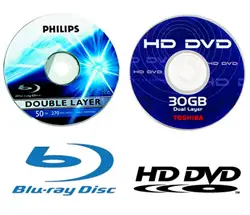HDTV format war: whose side to take?
Let’s get it out of the way first off: yes, the Blu–ray versus HD DVD
debate is a format war exactly like the Betamax vs. VHS war of the early 1980s, and we all know who won that one. This time though, there’s no clear winner so far, and the choice is made all the more confusing in that both the Blu–ray and HD DVD formats have advantages to them.
So, what are the differences? And which system to buy?
Of course, the main reason for introducing both new formats is HDTV, something that’s been just–around–the–corner for a few years now. HDTV, known as high–definition television, is the future format of TV with a resolution of 1125 lines vertically, compared to the old 480 lines standard of the past 50 years. In a nutshell, there’s a LOT more information (eye–candy detail) in an HDTV image, which means that movies released in HDTV formats take up a LOT more room on a disc.
Since current dual–layer DVDs only hold a maximum of up to 9.7 gigabytes of data, there simply isn’t enough space to store all the data that a two–hour HDTV movie contains. Hence the introduction of the competing Blu–ray and HD DVD formats: to provide lots of space for HDTV media. Either format provides ample disc space for the next generation of HDTV movies, TV shows and other media to be released to home consumers. Choosing which format is right for you depends on several factors.
An examination of technical specifications reveals that for the moment, Blu–ray has the edge in capacity: 50 gigabytes (GB) per dual–layer disc, at 25 GB per layer. There are rumours of larger–capacity Blu–ray discs with 100–200 gigabytes in the works, but those would be of interest only to PC users for data storage. The extra capacity would be wasted on only having a movie on the disc, even with extra features filling out the rest of the disc space.
As for HD DVD, its capacity is rated at 30 GB per disc, at 15 GB per layer. This falls short of Blu–ray’s specifications. Again, this is academic at the moment, as both formats allow for more than enough space to record the longest of movies at HDTV resolutions. Even adding extra features such as director’s commentaries, deleted scenes and the like still would leave room on an HD DVD, so again: space is not an issue overall.
One has to take care, though, as severe fingerprinting or scratches can ruin a disc in moments. Blu–ray states that it has an ‘improved hard coating’ on the discs that is ‘better than that of regular DVD coatings’ which they claim will better protect against scratches and fingerprints. However, HD DVDs record data on layers that are physically far removed from the disc’s surface, lessening the chance that scratches will corrupt the disc. The Blu–ray format records its data nearer the surface of the disk, which is somewhat riskier for those folk who don’t treat their disc collection with kid gloves at all times.
Some other points to consider: HD DVDs can be easily released as dual–format discs, with the HD DVD–formatted movie on one side and the regular–definition DVD version on the other side. This ensures that the disc can be played in any DVD player. The movie is not restricted to HD DVD players alone. The menu system from HD DVD seems more advanced, allowing viewers access to various menu functions while still watching the movie: no more exiting to the main menu to browse chapter lists, for example. Viewers can also save bookmarks with HD DVD or watch a second video stream (such as a director’s commentary) at the same time as the movie playback. Lastly, every HD DVD player made also includes an Ethernet port, allowing Internet firmware upgrades as well as other network expansion possibilities for the future.
However, it’s the market that makes or breaks new technology. This is where Blu–ray has shown its clout. Aside from the million–plus sales of Playstation3s (each of which has a Blu–ray player in it), seven of the eight major Hollywood studios now support Blu–ray: Warner, Paramount, Fox, Disney, Sony, MGM and Lionsgate. Meanwhile, HD DVD supporters to date only include Paramount and Universal, meaning your favourite movie may only be available in Blu–ray.
Another fact: HD DVD is region–free, unlike Blu–ray. This means that an HD DVD bought in one part of the world will work in ANY other country, a big departure from current DVD’s that will not work outside their sales region, such as North America. Many Europeans seem to have clued into this, as HD DVD sales have been very strong there to date.
Back in the 1980s, VHS won over the higher–resolution Beta format through sheer market dominance. The majority of movies were released on VHS. They were inferior in resolution to Beta but VHS made up for it by being both cheap and available everywhere.
In the end, the choice between Blu–ray and HD DVD is up to the consumer. On one hand, Blu–ray appears to be winning the studio war, meaning almost any movie will be available on Blu–ray. However, HD DVD has more useful features that allow the consumer to enjoy their viewing experience, as well as a region–free incentive that would allow HD DVDs purchased elsewhere in the world to work fine back home. Unless you are willing to purchase a very expensive dual–format player (such as LG makes) that can play both Blu–ray and HD DVD, you will have to decide which format best fits your needs.
As for which format will win in the end, only time and consumer wallets will tell. Until then, break out your old VHS collection to see just how great HDTV looks in comparison? Once you’ve seen the difference, you’ll never go low–definition again.

